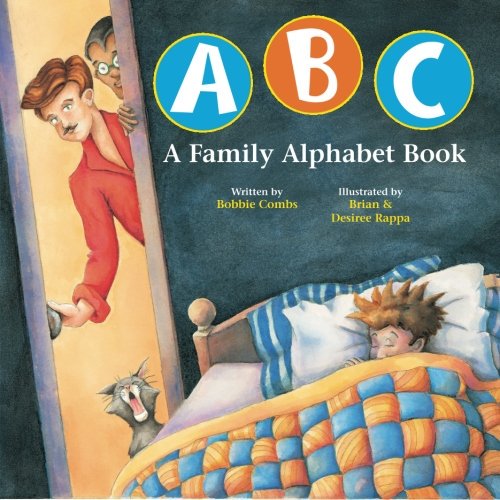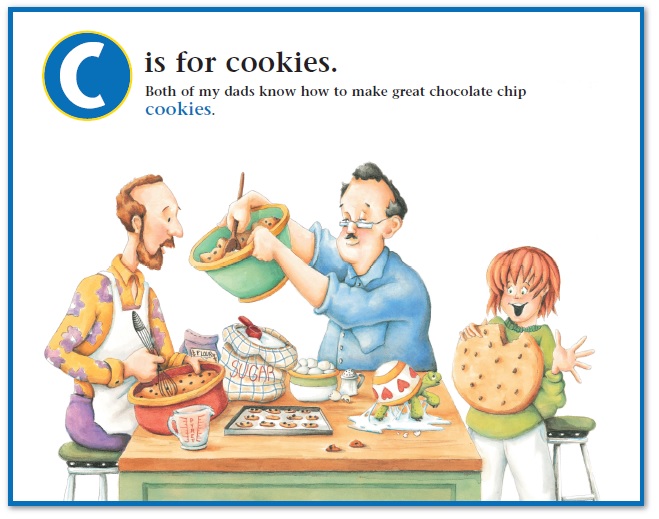
Inclusive Children's Book Teaching Guide
ABC: A Family Alphabet Book
What is this book about?
A is for awake, B is for books, C is for cookies, and D is for ducks. This inclusive alphabet book features everyday words and colorful illustrations that depict a day in the lives of children in Rainbow families.
The families play, explore their neighborhoods, shop, and visit the zoo in all kinds of weather and throughout the changing seasons.
Children will have fun pointing out the kids, moms, dads, and pets in this book that celebrates LGBTQ+ families while teaching early learners their ABCs.
Who is depicted in this book?
- Diverse children in different types of Rainbow families engaged in shared family experiences at home and in a variety of community settings
What early childhood themes and concepts does this book explore?
- Different kinds of families
- Familiar everyday activities that young children may recognize
- Since this is an alphabet book, capital letters and vocabulary (times of day, animals, clothing, activities, family-related words) are printed on each page with illustrations featuring each word within the context of family.
How does this book support anti-bias education?
ABC: A Family Alphabet Book can be used to affirm different types of families. It embeds basic vocabulary words into settings that represent Rainbow families, which is particularly important for children growing up in Rainbow families. At the same time, this book introduces other young children to the concept of family diversity.
Depending on how the book is shared or used—and the developmental level of the children—ABC: A Family Alphabet Book may be used to support the following core goals from Anti-Bias Education for Young Children and Ourselves:
Identity—Teachers will nurture each child’s construction of knowledgeable and confident personal and social identities so that children will demonstrate self-awareness, confidence, family pride, and positive social identities.
Diversity—Teachers will promote each child’s comfortable, empathetic interaction with people from diverse backgrounds so that children will express comfort and joy with human diversity, use accurate language for human differences, and form deep, caring connections across all dimensions of human diversity.
How can this book be used to meet early childhood learning standards?
For all ages
Use ABC: A Family Alphabet Book to meet early childhood literacy standards
For children from birth to age three
Teaching suggestion: Point out and talk about the letters, colors and familiar objects in the everyday lives of the families depicted in the book.
What Illinois Early Learning Guideline does this meet for children from birth to age three?
Developmental DomainLanguage Development, Communication and Literacy
Standard: Early LiteracyChildren demonstrate interest in and comprehension of printed materials.
Indicators for children:
- Points to familiar pictures and actions in books (16–24 months)
- Recites part of book from memory (21–36 months)
What Illinois Early Learning Guideline does this meet for children from birth to age three?
Developmental DomainCognitive Development
Standard: Concept DevelopmentChildren demonstrate the ability to connect pieces of information in understanding objects, ideas and relationships.
Indicators for children:
- Begins to identify and name objects and people (16–24 months)
- Begins to identify characteristics of an object, such as “red ball” (16–24 months)
- Identifies characteristics of objects and people when named, e.g., colors (21–36 months)
Teaching suggestion: Point out family members and encourage the children to name and talk about their own family members.
What Illinois Early Learning Guideline does this meet for children from birth to age three?
Developmental DomainSocial-Emotional Development
Standard: Self-ConceptChildren develop identity of self.
Indicators for children:
- Shows awareness of significant people by calling them by name, such as “papa” (7–18 months)
- Points to self in media (16–24 months)
- Names people in their family and shares stories about them (21–36 months)
For preschoolers (ages three to five)
Teaching suggestion: Identify letters while exploring the book.
What Illinois Early Learning and Development Standards does this meet for preschoolers?
Language Arts Standard4BDemonstrate an emerging knowledge and understanding of the alphabet.
Benchmark 4.B.ECa:
With teacher assistance, recite the alphabet.
Benchmark 4.B.ECb:
Recognize and name some upper/lowercase letters of the alphabet, especially those in own name.
Teaching suggestion: Point out the different family structures and answer the children’s questions about each family type. Introduce vocabulary words that the children can use when talking about the different types of families.
What Illinois Early Learning and Development Standards does this meet for preschoolers?
Social Studies Standard18BDevelop an awareness of self within the context of family.
Benchmark 18.B.ECa:
Understand that each of us belongs to a family and recognize that families vary.
Teaching suggestion: Invite the children to talk about their own family structures. Ask questions such as: "Who is in your family? What is the same and different among families? What is something great about your family?" Incorporate different types of families into pretend play and art projects.
What Illinois Early Learning and Development Standards does this meet for preschoolers?
Social Studies Standard18BDevelop an awareness of self within the context of family.
Benchmark 18.B.ECa:
Understand that each of us belongs to a family and recognize that families vary.
See inside this book.

